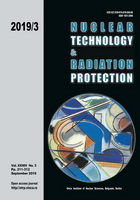
BEST ESTIMATE PLUS UNCERTAINTY APPROACH IN NUCLEAR REACTOR SAFETY AND LICENSING Brief History and Elements after Licensing

Vol.
XXXIV, No. 3, Pp. 211-312
September 2019
UDC 621.039+614.876:504.06
ISSN 1451-3994
Pages: 299-312
Authors: Francesco S. D'auria and Giorgio M. GalassiAbstract
The best estimate plus uncertainty is, at the same time, an approach, a procedure and a framework in nuclear thermal-hydraulics and nuclear reactor safety and licensing. The motivation at the basis of the best estimate plus uncertainty is the lack of knowledge in the areas of single and, mainly, two-phase transient thermal-hydraulics. In other terms and introducing some simplifications, the insufficient knowledge of turbulence imposes the design of roadmaps for the application of imperfect (thermal-hydraulic) models to the evaluation of design features and of safety for complex technological installations or systems like the nuclear power plants and, more specifically, the water cooled nuclear reactors. Furthermore, the legal counterpart of nuclear reactor safety, or the licensing, is concerned: therefore the best estimate plus uncertainty must account for rules and regulations derived from the fundamental radioprotection principle which imposes the minimization of the impact of radiations upon humans and the environment under any circumstance. In the present paper, the key elements of the approach are identified and characterized. These shall be seen as the support for a consistent application of thermal-hydraulics to the design and safety of water-cooled nuclear reactors.
Key words: best estimate, uncertainty evaluation, best estimate plus uncertainty, licensing process, validation, scaling
FULL PAPER IN PDF FORMAT (625 KB)